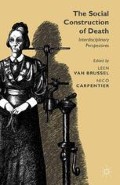Abstract
Before the twenty-first century, crime shows tended to show victims only at the crime scene. With the rise of TV shows like CSI and Six Feet Under, the dead body became a central actor in the plot. Dead bodies were not only at the crime scene now, but also in the morgue, the embalming room and most often in the pathology lab. The dead body — especially when represented in visual media — is now indeed ‘treated as a highly spectacular object, and the dead body at autopsy becomes the most spectacular’ (Klaver, 2006, p. 140). Before the turn of the century there was only one show on TV (Quincy, M.E.) that presented corpses in the pathology lab. These first representations of corpses stand in contrast to the representations in TV shows from 2000 to 2010. This contrast is marked by a shift towards a greater visibility of corpses, which are now far less often obscured. The increasing visibility of corpses on TV is interesting as mass media are to be regarded as key spheres of meaning making, reproducing as well as shaping more encompassing societal conceptions of death. Given that most people have never been within a pathology department or attended autopsies, media images from crime TV shows create a visual experience from which they were previously excluded.
Access this chapter
Tax calculation will be finalised at checkout
Purchases are for personal use only
Preview
Unable to display preview. Download preview PDF.
References
Akass, K. and McCabe, J. (eds) (2005). Reading six feet under: TV to die for. London: I.B. Tauris.
Ariès, P. (1984). Bilder zur Geschichte des Todes. Munich, Vienna: Hanser.
Baudrillard, J. (1993). Symbolic exchange and death. London, New York: Sage.
Belting, H. and Macho, T. (2006). ‘Hans Belting und Thomas Macho im Gespräch. Die neue Sichtbarkeit des Todes’, in T. Macho and K. Marek (eds) Die neue Sichtbarkeit des Todes. Munich: Fink, pp. 235–260.
Bostnar, N., Pabst, E. and Wulff, H. J. (eds) (2008). Einfährung in die Film-und Fernsehwissenschaft. Stuttgart: UTB.
Bordwell, D. and Thompson, K. (2003). Film art: an introduction. New York: McGraw-Hill.
Bronfen, E. (1992). Over her dead body: death, femininity and the aesthetic. Manchester: University Press, Manchester.
Carpentier, N. and Spinoy, E. (eds) (2008). Discourse theory and cultural analysis: media, arts and literature. Cresskill, NJ: Hampton Press.
Daermann, I. (1998). Tod und Bild: Eine phänomenologische Mediengeschichte. Munich: Fink Verlag.
Elias, N. (1939). Über den Prozeß der Zivilisation. Bazel: Haus Zum Falken.
Elias, N. (1980). Ueber den Prozess der Zivilisation: Soziogenetische und psychogenetische Untersuchungen. II 2: Wandlungen der Gesellschaft. Entwurf zu einer Theorie der Zivilisation. 7. Aufl. Frankfurt/M.: Suhrkamp.
Featherstone, M. (2010). ‘Body image and affect in consumer culture’, Body Society, 16(193), DOI: 10.1177/1357034X09354357
Foltyn, J. (2006). ‘Dead sexy: post-disaster/terrorism voyeurism and the corpse, pop culture’s new porn star’. Retrieved from http://www.bath.ac.uk/podcast/lectures/002-podbath-Deadsexy.mp3, date accessed 23 June 2009.
Foucault, M. (2002 [1969]). The archaeology of knowledge (trans. A. M. Sheridan Smith). London and New York: Routledge.
Goodman, N. (1995). Sprachen der Kunst: Entwurf einer Symbol theorie. Frankfurt/M.: Suhrkamp.
Hanusch, F. (2010). Representing death in the news. New York: Palgrave.
Hickethier, K. (1993). Film-und Fernsehanalyse. Stuttgart: Metzler.
Kellehear, A. (2007). A social history of dying. Cambridge: Cambridge University Press.
Klaver, E. (2006). Sites of autopsy in contemporary culture. Albany, NY: State University of New York Press.
Klein, G. (2001). ‘Der Körper als Erfindung’, in R. von Gero (ed.) Wie viel Koerper braucht der Mensch? Hamburg: Körber-Stiftung, pp. 54–62.
Kuchenbuch, T. (2005). Filmanalyse: Theorien — Methoden — Kritik. Vienna: UTB.
Luhmann, N. (1996). The reality of mass media. Stanford, CA: Stanford University Press.
Mayerhausen, T (2006). ‘Diskursive Bilder? Überlegungen zur diskursiven Funktion von Bildern in polytechnologischen Dispositive’, in S. Maasen, T Mayerhauser and C. Renggli (eds) Bilder als Diskurse — Bilddiskurse. Weilerswist: Velbrück, pp. 71–94.
Maasen, S., Mayerhausen, T. and Renggli, C. (eds) (2006). Bilder als Diskurse —Bilddiskurse. Weilerswist: Velbrück.
Mcllwain, C. D. (2004). When death goes pop: death, media and the remaking of community. New York: Peter Lang.
Menninghaus, W. (2003). Disgust: the theory and history of a strong sensation. Albany, NY: State University of New York Press.
Menninghaus, W. (2007). Das Versprechen der Schoenheit. Frankfurt/M.: Suhrkamp.
Merta, S. (2008). Ein Körperkult der Moderne. Stuttgart: Steiner Verlag.
Monaco, J. (2000). Film verstehen. Hamburg: Europa Verlag.
Mueller-Doohm, S. (1997). ‘Bildinterpretation als struktural-hermeneutische Symbolanalyse’, in R. Hitzler and A. Honer (eds) Sozialwissenschaftliche Hermeneutik: Eine Einfuehrung. Opladen: Leske Budrich, pp. 81–108.
Posch, W. (2009). Projekt Koerper: Wie der Kult um die Schoenheit unser Leben praegt. Frankfurt am Main: Campus.
Schwan, S. (2005). ‘Film verstehen — Eine kognitionspsychologische Perspektive’, in K. Sachs-Hombach (ed.) Bildwissenschaft zwischen Reflexion und Anwendung. Cologne: Herbert von Halem Verlag, pp. 457–467.
Seer, U. (1992). Was Farben uns verraten. Stuttgart: Kreuz-Verlag.
Trebess, A. (2006). Metzler-Lexikon Ästhetik. Kunst, Medien, Design und Alltag. Stuttgart: Metzler.
Weber, T. (2006). ‘Codierungen des Todes. Zur filmischen Darstellung von Toten in der amerikanischen Fernsehserie “Six Feet Under”’, in T. Macho and K. Marek (eds) Die neue Sichtbarkeit des Todes. Munich: Fink, pp. 541–557.
Welsch, W. (1996). Grenzgänge der Ästhetik. Stuttgart: Philipp Reclam.
Villa, P. (2008). Schoen normal: Manipulationen am Körper als Technologien des Selbst. Bielefeld: Transcript Verlag.
Zettl, H. (1973). Sight—sound—motion. Belmont: Wadsworth Pub. Co.
Zettl, H. (2002). ‘Essentials of applied media aesthetics’, in C. Dora and S. Venkatesh (eds) Media Computing: Computational Media Aesthetics. Boston, Dordrecht, London: Kluwer Academic Publishers, pp. 11–35.
Zettl, H. (2008). Sight, sound, motion; applied media aesthetics (5th ed.) Belmont: Wadsworth Pub. Co.
Author information
Authors and Affiliations
Editor information
Editors and Affiliations
Copyright information
© 2014 Tina Weber
About this chapter
Cite this chapter
Weber, T. (2014). Representations of Corpses in Contemporary Television. In: Van Brussel, L., Carpentier, N. (eds) The Social Construction of Death. Palgrave Macmillan, London. https://doi.org/10.1057/9781137391919_5
Download citation
DOI: https://doi.org/10.1057/9781137391919_5
Publisher Name: Palgrave Macmillan, London
Print ISBN: 978-1-349-48313-6
Online ISBN: 978-1-137-39191-9
eBook Packages: Palgrave Media & Culture CollectionLiterature, Cultural and Media Studies (R0)

